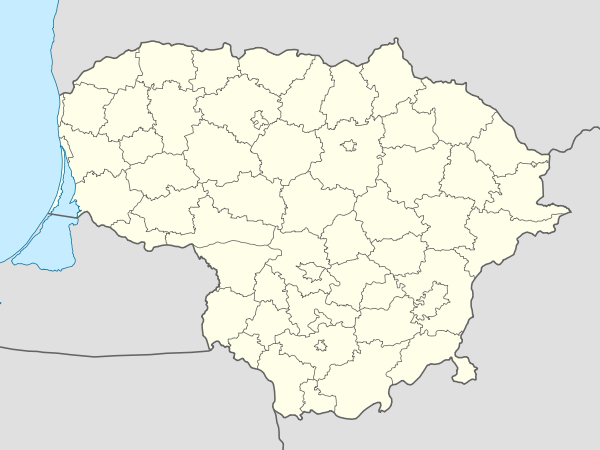Tauragė
| Tauragė | |||
|---|---|---|---|
| City | |||
|
| |||
| |||
 Tauragė Location of Tauragė | |||
| Coordinates: 55°15′08″N 22°17′23″E / 55.25222°N 22.28972°ECoordinates: 55°15′08″N 22°17′23″E / 55.25222°N 22.28972°E | |||
| Country |
| ||
| Ethnographic region | Samogitia | ||
| County | Tauragė County | ||
| Municipality | Tauragė district municipality | ||
| Eldership | Tauragė town eldership | ||
| Capital of |
Tauragė County Tauragė district municipality Tauragė town eldership Tauragė rural eldership | ||
| First mentioned | 16th century | ||
| City status | 1932 | ||
| Area | |||
| • Total | 15.7 km2 (6.1 sq mi) | ||
| Elevation | 38 m (125 ft) | ||
| Population (2016) | |||
| • Total | 23,120 | ||
| • Density | 1,500/km2 (3,800/sq mi) | ||
| Time zone | EET (UTC+2) | ||
| • Summer (DST) | EEST (UTC+3) | ||
| Postal code | 72001 | ||
| Website |
www | ||
Tauragė (![]() pronunciation ; see other names) is an industrial city in Lithuania, and the capital of Tauragė County. In 2011, its population was 26,444. Tauragė is situated on the Jūra River, close to the border with the Kaliningrad Oblast, and not far from the Baltic Sea coast.
pronunciation ; see other names) is an industrial city in Lithuania, and the capital of Tauragė County. In 2011, its population was 26,444. Tauragė is situated on the Jūra River, close to the border with the Kaliningrad Oblast, and not far from the Baltic Sea coast.
Tauragė received its city charter in 1932, and its coat of arms (a silver hunting horn in a red field) in 1997. Notable buildings in the city include the neo-Gothic Radziwiłł palace - "the castle" (currently housing a school and regional museum Santaka) and several churches: the Lutheran (built in 1843), the Orthodox (1853) and the Catholic churches (1904). A ceramics manufacturing plant operates in the city.
Etymology
In Lithuanian, Tauragė is a conjunction of two words: Tauras which means aurochs, and ragas which means horn, hence its coat of arms. The city is known as Tauroggen in German, as Taurogi in Polish, טאווריג/Tovrig in Yiddish, and Тауроген, Тауроги/Taurogen, Taurogi in Russian.
History

One of the major residences of the Radziwiłł family since 1655, the city has been a center of Lutheranism in Lithuania. From 1691 until 1795, Tauragė belonged to Brandenburg-Prussia, after the marriage of Margrave Ludwig of Brandenburg with Princess Ludwika Karolina Radziwiłł. Afterwards, the city became part of the Russian Empire.
Tsar Alexander I of Russia, signed an armistice with Napoleon I in Tauragė on June 21, 1807, that was soon to be followed with the Treaties of Tilsit. On December 30, 1812, the Prussian General Yorck, signed the Convention of Tauroggen, declaring his troops neutral, that effectively ended the fragile Franco-Prussian alliance during the French invasion of Russia. In 1836, much of the city was destroyed by a fire. Honoré de Balzac stayed in Tauragė in 1843.[1]
In 1915, a significant part of the city's infrastructure was destroyed by German troops during World War I. On September 9, 1927, there was a rebellion against the rule of President Antanas Smetona, but the revolt was quickly suppressed. After the Soviet annexation of Lithuania in 1940, the "Tauragė Castle" was a place of imprisonment for Lithuanian political dissidents and Polish POWs. Many local inhabitants, including the parents and relatives of Roman Abramovich, were exiled to Siberia during the Soviet occupation in 1940. This saved the family from the Holocaust. When Operation Barbarossa commenced on June 22, 1941, the Soviets retreated, and Tauragė was captured by the German Wehrmacht on the same day. About 4,000 Jews were murdered in Tauragė and nearby villages. In the autumn of 1944, the German occupation ended with the Soviets replacing them with a renewed occupation lasting until 1990.
International relations

Twin towns — Sister cities
Tauragė is twinned with:
References
- ↑ Mažrimas, Edmundas (2008-06-26). "Prancūzų rašytojas Onorė de Balzakas ir Tauragė". Tauragės kurjeris. Retrieved 2010-03-13.
- ↑ "Portal Bełchatów" [Bełchatów - Partnership Cities]. Miasto Bełchatów [Bełchatów town council] belchatow.pl (in Polish). 2010. Archived from the original on 13 June 2011. Retrieved 22 June 2011.
External links
| Wikimedia Commons has media related to Tauragė. |
- Municipal website (Lithuanian)
- Randburg.com
- Aerial photo from January, 1945
- The murder of the Jews of Tauragė during World War II, at Yad Vashem website.

.svg.png)
